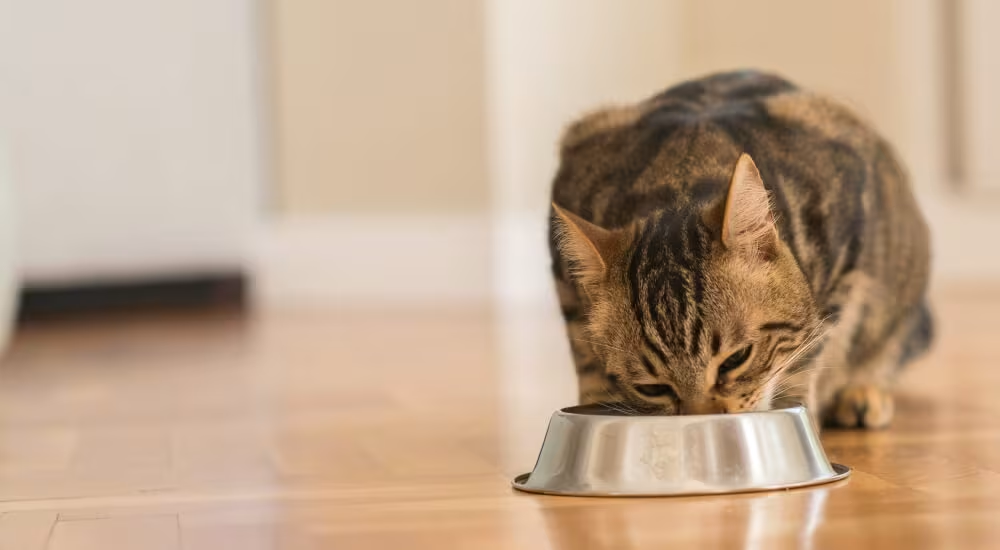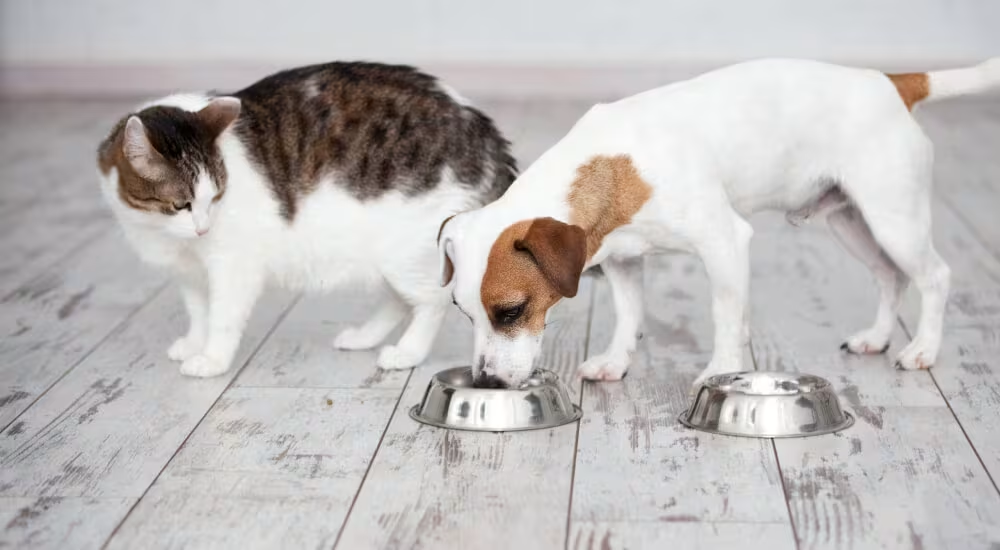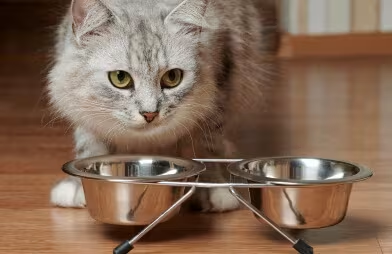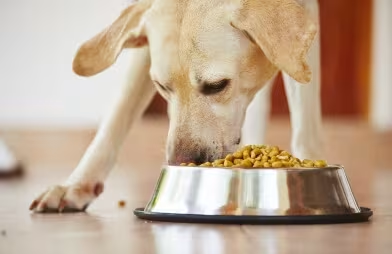Tell a dog it's time to eat and you're almost guaranteed to get an enthusiastic reaction. Even a cat might acknowledge your existence for a moment when their favourite food makes an appearance.
Feeding your furry friend a nutritious diet is a key responsibility of pet parenthood, but it can also be a huge source of joy to see your dog or cat eating a meal that is both good for them, and one they enjoy.
Finding the "right" pet food sometimes feels like a monumental task as there are so many options available. Making that choice is all about asking the right questions, and looking to experienced pet professionals for answers—which is exactly what we did.
Here's the best food and feeding advice our vets, nutritionists, and Animal Care Experts had to share:
Puppies and kittens need puppy and kitten food
In the same way a parent wouldn’t order steak tartare with a side of escargot for their human baby, you also don’t want to give a puppy or kitten food meant for adult animals.
Pet food that’s formulated for early stages of life contains vitamins and minerals crucial for your pet’s growth and development. These foods typically feature higher levels of protein, fat, calories, and the omega fatty acid DHA, (which is also found in their mother’s milk).
In short, they have all the ingredients a fast-growing young pet needs to grow into a strong and healthy adult animal.
That said, our product developer and nutritionist Kylie Hogan advises pet parents to get their kittens and puppies trying a variety of foods early in life. “You want to introduce them to as much as you can, but keeping that base food the same is the most important thing so that they sustain proper growth,” she says. Hogan recommends using treat time to introduce them to other nutritious foods.
Should a senior pet eat a different diet?
Consulting a vet about your senior pet’s nutritional needs is your best bet, because some of the diseases that affect older animals can be managed with nutrition (for example dental disease, arthritis, and obesity).
“Having a dog be overweight is one of the worst things you can do for their health,” says Hogan, who explains that if a diet is working for your adult dog or cat, you don’t necessarily have to change it, but you may need to alter portion sizes depending on their level of activity.
“Older animals already have some joint problems. So if they're gaining weight, it's just going to add to that,” she says. “Other things you might want to do is feed a wet food and mixed blended proteins. I love feeding dry and wet because I think they both have benefits, especially for cats. The more water you can get in your animal, the better.”
Hogan also recommends considering supplements for older dogs. “Most senior diets have glucosamine in them for joint health and increased omega fatty acids. But that's something you may need to supplement in the winter, if their joints are feeling a little bit more achy.”
Providing a well-balanced diet
For dogs, meat matters, and should be the primary ingredient in their diet, whether they eat wet dog food, dog kibble, or pre-packaged frozen raw dog food. However, a balanced diet will also contain vegetables, grains, and fruits, as sources of all-important vitamins and minerals.
Grains are a source of fibre but some pet parents have opted to go grain-free. “Taurine is a nutrient that everybody needs,” says veterinarian Dr. Garrett Schuilenberg. “Dogs get their taurine from metabolizing grain.
When it comes to cat food, your biggest issue is likely finding a diet these notoriously picky eaters will adapt to. As a meat eater, your cat needs a high amount of protein, a moderate amount of fat, and minimal carbs.
Cats also get a lot of their hydration from their food, which is a big reason to consider feeding your feline wet cat food or prepackaged frozen raw cat food. Or simply supplementing their dry food with a portion of wet food.
Key ingredients to look for in cat food include meat and meat byproducts, poultry and poultry byproducts, grain, fish meal, milk products, and vitamin and mineral supplements
To raw or not to raw, that is the question
Should you go raw? Raw food diets for both cats and dogs are a common topic of conversation these days.
Of course, like all important decisions, the answer isn’t a simple yes or no and in the end it’s up to you. You’ll want to consider the specific needs of both you and your pet, and consider where you buy your raw meals from.
Dr. Schuilenberg says he does not recommend pet parents buy meat from a grocery store or butcher and bring it home to cook, as food handling can introduce harmful bacteria if it is not done properly.
"I think vets notoriously get pegged as anti-raw, but there are safer ways to introduce it," says Dr. Schuilenberg. "If I was going to recommend something similar, I would say: Get your raw meat and at least—at the very minimum—sear the outside of it. Because there's evidence that even cooking just the outside of the meat is going to eliminate a good percentage of the bacteria, viruses, and parasites that are on it."” "
Commercially produced raw pet food, however, is tested for bacteria like E. coli, Listeria, and Salmonella before it’s packaged, making it safer than butcher meat.
If you decide to feed your pet a raw diet, Dr. Schuilenberg recommends waiting until they are at the adult stage. “I always tell people not to feed raw until your pet is fully grown,” he says. “Puppies and kittens have different nutritional requirements while they're growing. They have different needs for calcium, phosphorus, and things like that. And those raw diets really are made for adults.”
In addition, Dr. Schuilenberg offers a word of caution around handling and preparing raw food in households with young children, older grandparents, or anyone who is immunocompromised: “A pet that eats raw also carries higher numbers of these pathogens in their mouth, and a loving dog lick could be more dangerous than one might think," he says.
Transitioning or adding raw food to your pet’s diet
Pet Valu store manager, Amanda Lisi, feeds her own dogs raw food, and often shares information about her experience with curious pet parents who wonder if the diet is the right fit for their furry friend.
“I've talked to raw food manufacturers myself about this,” she says. “It is totally safe to mix [raw and kibble] together. I just suggest doing a little bit in the morning, trying that, and then doing their kibble meal at nighttime. Just like you would if you were switching kibble brands, add in a little bit, take out a little bit of their old stuff, and then 50/50, and then eventually full.”
When it comes to researching a raw diet for your pet, Lisi says there is no such thing as a dumb question. “There's a lot that goes into feeding and making sure that it's done properly,” she says. “I get a lot of people that think they can go to the grocery store and give their pet a steak, but it's totally different. Look at the brands that our store carries. And don't be afraid to research and ask your vet.”
Store manager Amy Koehler agrees, saying that commercially made raw food is best in terms of nutritional completeness and safety. She likes to add an omega supplement for her dog, along with some frozen goat milk to aid in digestion.
When it comes to the benefits of raw diets for cats, and dogs, Dr. Schuilenberg says his patients occasionally do report seeing a difference with their animals.
“Some people find that their animals will have smaller stools that are not quite so messy,” he says. “To me that indicates that the digestibility of these raw foods may be better in some cases and that they're absorbing more of the nutrients out of it.”
Recommended steps to take your pet from kibble to raw:
If you want to take your pet from dry kibble to raw meals, the process should take about 10 days and mealtime should look as follows:
Day 1-3: Fill your pet’s bowl with 3/4 dry kibble and 1/4 raw food.
Day 4-6: Move to half-and-half dry and raw food.
Day 7-9: Reduce the dry food component of mealtime to 1/4, and raw can make up 3/4 of the dish.
Day 10: Move to 100% raw.
A good rule of thumb: Any food that makes up one-third of the bowl should be complete and balanced.
If your pet is showing any signs of gastrointestinal distress, add a tablespoon of goat’s milk, a probiotic supplement, or pumpkin to aid in digestion. Pro tip: bone broth can also be added to enhance flavour.
When serving raw food, dish it out to your pet at room temperature to enhance the aroma of the food to make it more enticing. Some pets are known to vomit their meal if it’s served cold right from the fridge.
What is rotational feeding?
Rotational feeding—switching up your pet’s proteins from, say, beef to fish to kangaroo to rabbit—offers a long list of benefits. It can help with everything from weight control to food intolerances.
“Rotating proteins is good for a few reasons,” says Lisi. “It creates a nutrient balance because all proteins are not made the same. And it reduces the chance of protein intolerance. It’s rare that my dogs get the same thing each day. It's always rotated out. They get something new and they're excited when it's time for feeding.”
Besides the novelty of new tastes, Hogan’s perspective as a nutritionist is that rotational feeding can be a good strategy for managing your pet’s health over the course of the year.
“What's most important is rotating your food where the seasons really come into play,” she says. “If you have a pet who's prone to weight gain or you can't exercise them as much, you might want to switch to a weight control food. That would mean higher protein, lower fat, higher fibre.”
More time outside could also lead to different nutritional needs, which can be satisfied by rotational feeding.
“You probably also want to switch to something that's going to complement that,” says Hogan. “Something that has more fish in it which is really good for skin and coat if they're going to be outside in the elements more. It's also better for joint health if they're going to be running around a lot more. Also when you're going into those more active months, you can go to a higher protein, higher fat diet because they need that extra energy.”
Cats, however, can be more resistant to menu changes, making rotational feeding more challenging.
“Cats are so finicky when it comes to the kind of nutrient issues they can develop over their age,” Hogan explains. “So if you find a food that they like, and you find rotational feeding doesn't really work for you, then you can just rotate wet cat food . And that's an easy way to change their calorie makeup so that they can eat less or more, and also provide any seasonal changes, like the dry skin and coat and maybe more activity as well.”
Help! I think my pet has a food allergy
Food allergies and sensitivities can be tough on pets and pet parents alike, but our experts have a variety of solutions to consider.
Typically, a food allergy or insensitivity is linked to a specific protein or carbohydrate, and an elimination diet trial is the most meaningful way to test for food allergies and help narrow down which element it is that’s aggravating your pet, says Dr. Schuilenberg.
Raw diets are another option for pet parents with an allergic dog or cat. “The reason why I would recommend something like that would be for some sort of animal that has an allergy that we just cannot figure out, where we need to know exactly what is going into the diet,” says Dr. Schuilenberg.
Dr. Schuilenberg says he’s also advised vegetarian diets for certain dogs with allergies.
“This diet is reserved for dogs with skin allergies and things like that, where we're trying to figure out what can fix this,” he says. “Another reason would be some sort of digestive issue where we can't find a kibble that they can digest. Maybe we tried raw and they don't do well on raw so we try vegetarian,” he explains.
Cat parents, however, need to be aware that while raw is a feeding option for their feline, vegetarian diets are definitely not. Cats are obligate carnivores, and their evolutionary adaptations make them dependent on the consumption of animal protein to survive. The requirements of a cat’s metabolism prevent them from thriving on a plant-based diet.

















































